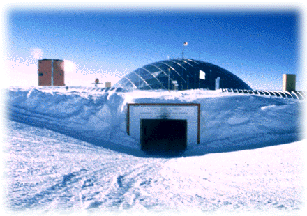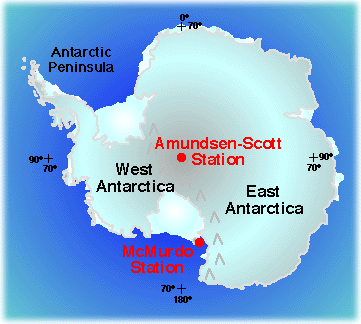
|
|





See Linda's Expedition Pictures

I have been teaching fourteen years and currently am teaching chemistry
and environmental science at Sam Houston High School in Lake Charles, Louisiana.
I am married with two children. What free time I have is spent cycling,
hiking, and playing with computers.
The Antarctic is the location of some of the most important global climate
research done anywhere on Earth! It is a land of complex scientific, political
and environmental issues. I am excited about parcticipating in an atmospheric
science research project with Dr. Frank Murcray at the University of Denver.
I will assist Dr. Murcray's team in the installation of delicate atmospheric
monitoring equipment at the South Pole at Amundsen-Scott
Station. The station is very busy, especially during the short summer
field season. Because so much research must be conducted at the station
facilities in such a short amount of time, we have a small window of opportunity
to conduct our experiments.

The instruments that we will be testing are an infrared
emission spectrometer and an infrared absorption spectrometer. We want to
learn more about Earth's atmosphere, and phenomena such as the ozone
hole.
The optical properties of Earth's atmosphere largely are determined by the
chemical
composition of the atmosphere. Since oxygen and nitrogen are not active
in the infrared, the infrared optical properties of the atmosphere are determined
by the concentration of minor and trace gases. We will install an infrared
emission spectrometer at the South Pole and an infrared absorption spectrometer
at McMurdo Station.
The absorption spectrometer relies on absorption of solar radiation. Because
this type of instrument relies on obtaining data when the sun is above the
horizon, the installation of an infrared emission spectrometer will
allow year round measurements. The pristine, dry conditions and the steady
state conditions of the atmosphere of the South Pole allows ground-based
instruments to sense ozone photochemistry.
I will keep you posted on the progress of my travels and the experiments
when we get underway!

Infrared Measurements in Antarctica
Principal Investigator: Frank J Murcray,
University of Denver
 I was a member of a team researching the ozone hole over Antarctica. Atmospheric components involved in the chemical destruction of ozone absorb and emit infrared radiation. They can be studied using remote sensing instruments (Michelson interferometers) that detect infrared wavelengths. Remote sensing is the use of electromagnetic radiation to collect information about an area without actually visiting it.
I was a member of a team researching the ozone hole over Antarctica. Atmospheric components involved in the chemical destruction of ozone absorb and emit infrared radiation. They can be studied using remote sensing instruments (Michelson interferometers) that detect infrared wavelengths. Remote sensing is the use of electromagnetic radiation to collect information about an area without actually visiting it.
Ozone is a form of oxygen that contains three atoms per molecule. It occurs naturally in the stratosphere, the part of the atmosphere between 10 and 50 kilometers (6 and 31 miles) above Earth's surface. Ozone occurs in a layer in the stratosphere, where it absorbs ultraviolet radiation from the sun. Ultraviolet radiation that reaches the Earth's surface can cause skin cancer and can damage plants. Over the past several decades an annual "hole" in the ozone layer has developed over Antarctica each spring. Sunlight is absent from polar regions during the long, dark winter. Return of solar radiation provides the energy to drive chemical reactions involving man-made chemicals such as CFC's (ChloroFluoroCarbons). These chemicals accumulate in the polar stratosphere during the winter. In the presence of sunlight they destroy ozone. The end result is to convert three-atom oxygen molecules (ozone) into molecules containing only two atoms of oxygen. This form of oxygen (which we breathe) is ineffective in absorbing ultraviolet radiation.
The Michelson interferometers used in this study are being operated at two Antarctic sites. They can measure many industrial compounds involved in ozone destruction, such as chlorine and bromine compounds (including CFC's) as well as nitrogen oxides. CFC's are employed in refrigeration systems and aerosols, among other uses. Nitrogen oxides produced by combustion and are emitted by aircraft. The presence of these components in the atmosphere will be measured throughout the year, and special attention will be paid to the conditions leading up to the development of the annual ozone hole.
The interferometer at McMurdo Station measures infrared absorption of solar radiation in the atmosphere. It can make measurements only when sunlight reaches the Antarctic region, so it does not collect data during the long, dark winter. The interferometer at the South Pole measures infrared emissions, so it can collect data throughout the year. Even though the infrared absorption interferometer only works when the sun is above the horizon, it is used because it is a more sensitive instrument.
Some decrease in ozone levels has been observed at lower latitudes, where
most of us humans live. Decreases in atmospheric ozone result in increased
amounts of harmful ultraviolet radiation reaching the surface of the
Earth. Remote sensing by satellites is being used to monitor global ozone
levels.
Polar Classroom Activities:
Wind
Chill!!!
Overhead Spectroscopy
Physics
of Antarctic Snow Domes

Summer living quarters for visiting scientists at Amundsen-Scott Station. Photograph courtesy of Erik R. Venteris, The Ohio State University.

December 1996
| Su |
Mo |
Tu |
We |
Th |
Fr |
Sa |
| 1 |
2 |
3 |
4 |
5 |
6 |
7 |
| 8 |
9 |
10 |
11 |
12 |
13 |
14 |
| 15 |
16 |
17 |
18 |
19 |
20 |
21 |
| 22 |
23 |
24 |
25 |
26 |
27 |
28 |
| 29 |
30 |
31 |
-- |
-- |
-- |
-- |
November 1996
| Su |
Mo |
Tu |
We |
Th |
Fr |
Sa |
| -- |
-- |
-- |
-- |
-- |
1 |
2 |
| 3 |
4 |
5 |
6 |
7 |
8 |
9 |
| 10 |
11 |
12 |
13 |
14 |
15 |
16 |
| 17 |
18 |
19 |
20 |
21 |
22 |
23 |
| 24 |
25 |
26 |
27 |
28 |
29 |
30 |
Return to top of page
|








 I was a member of a team researching the ozone hole over Antarctica. Atmospheric components involved in the chemical destruction of ozone absorb and emit infrared radiation. They can be studied using remote sensing instruments (Michelson interferometers) that detect infrared wavelengths. Remote sensing is the use of electromagnetic radiation to collect information about an area without actually visiting it.
I was a member of a team researching the ozone hole over Antarctica. Atmospheric components involved in the chemical destruction of ozone absorb and emit infrared radiation. They can be studied using remote sensing instruments (Michelson interferometers) that detect infrared wavelengths. Remote sensing is the use of electromagnetic radiation to collect information about an area without actually visiting it.
